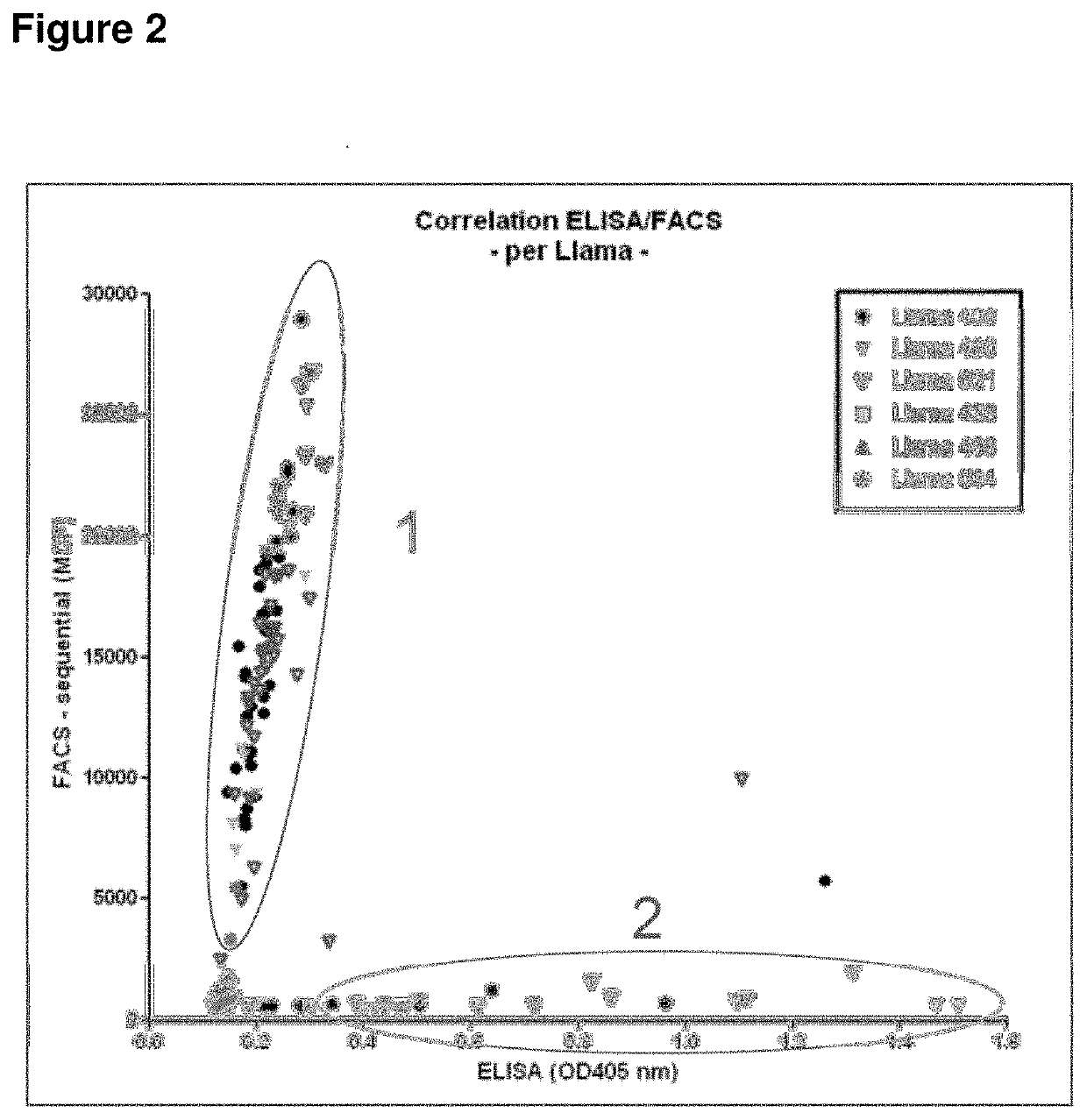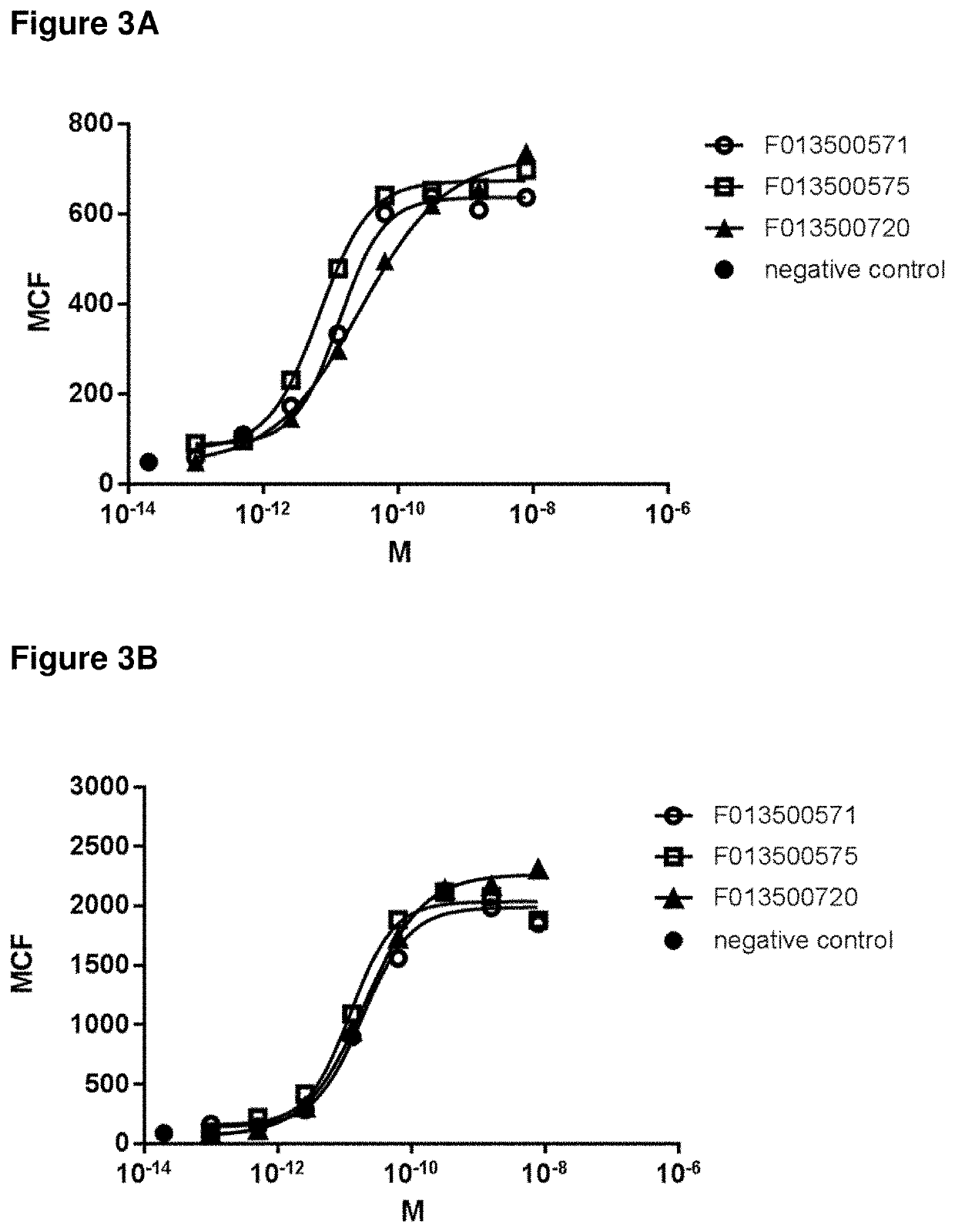Biparatopic polypeptides antagonizing wnt signaling in tumor cells
a polypeptide and tumor cell technology, applied in the field of biparatopic polypeptides antagonizing wnt signaling in tumor cells, can solve the problems of inability to define the exact epitopes involved in wnt1 or wnt3a ligand binding, inability to elucidate the epitopes within the beta-propeller 1, 2 and 3 domains involved in dkk1 binding to lrp6, and inability to cause sever
- Summary
- Abstract
- Description
- Claims
- Application Information
AI Technical Summary
Benefits of technology
Problems solved by technology
Method used
Image
Examples
example 1
ion of Llamas with LRP5 and LRP6 for the Induction of Humoral Immune Responses
[0287]Several protocols for the immunization of llamas needed to be worked out and implemented for identification of LRP5 / LRP6 cross-reactive binding VHH domains: Llamas were initially immunized with recombinant extracellular domains of LRP6 and LRP5 proteins (human and mouse). However, functional characterization of the above mentioned LRP5 recombinant protein revealed that only the Wnt1 class binding epitope was properly folded. In contrast, there was no indication for proper folding of the LRP5-Wnt3a class binding domain. Thus, further work was required to develop suitable antigens for immunization. As a work-around, llamas were immunized with HEK293 cells stably transfected with human LRP5 or human LRP6. However, also then, only very low expression of human LRP5 could be achieved, by transient or by stable transfection, and using different cell lines (HEK293, CHO and NIH-3T3 cells). Thus, even further ...
example 2
of LRP5 and LRP6 Binding Monovalent VHH Domains (VHHs)
[0290]Library Construction:
[0291]Total RNA was extracted immediately following collection of the immune tissues, and RNA integrity and concentration was verified. cDNA samples were made from these RNA preparations. Nucleotide sequences encoding VHHs were amplified from the cDNA samples in a one-step RT-PCR reaction. The 700 bp amplicons specifically amplified from the IgG2 and IgG3 cDNAs in the sample were isolated from agarose gel and subsequently used as template in a nested PCR reaction. The PCR products were subsequently digested with Sfil and BstEll and ligated into the corresponding restriction sites of phagemid vector pAX50. The ligation mixtures were electroporated into Escherichia coli TG-1. The resulting pool of transformants constituted the genetic diversity of the phage display library.
[0292]pAX50 is an expression vector derived from pUC119, which contains a resistance gene for ampicillin and the lac promoter followed...
example 3
of the Monovalent VHHs
[0300]After selection, clones were grown in 96 deep well plates (1 mL volume), and VHH expression was induced by adding IPTG. Periplasmic extracts of single clones were prepared according to standard methods, as e.g. reported in WO2011 / 107507, and screened for binding to human LRP6 and LRP5. Initially, to the periplasmic extracts were screened in binding ELISA assays using recombinant LRP5 and LRP6, which represent sensitive, robust and high-throughput assays, when compared to FACS-based binding assays. After purification, VHHs identified in ELISA assays were further characterized using binding FACS assay to confirm binding of purified VHHs to the LRP5 and LRP6 receptors in their native conformation.
[0301]Usually, a good correlation between ELISA and FACS binding assays is expected. However, in the present case, the best LRP5 and LRP6 binding VHHs in ELISA assays (i.e. with high affinity to recombinant LRP5 or LRP6 ectodomain) did not show any binding or very w...
PUM
 Login to View More
Login to View More Abstract
Description
Claims
Application Information
 Login to View More
Login to View More - R&D
- Intellectual Property
- Life Sciences
- Materials
- Tech Scout
- Unparalleled Data Quality
- Higher Quality Content
- 60% Fewer Hallucinations
Browse by: Latest US Patents, China's latest patents, Technical Efficacy Thesaurus, Application Domain, Technology Topic, Popular Technical Reports.
© 2025 PatSnap. All rights reserved.Legal|Privacy policy|Modern Slavery Act Transparency Statement|Sitemap|About US| Contact US: help@patsnap.com



